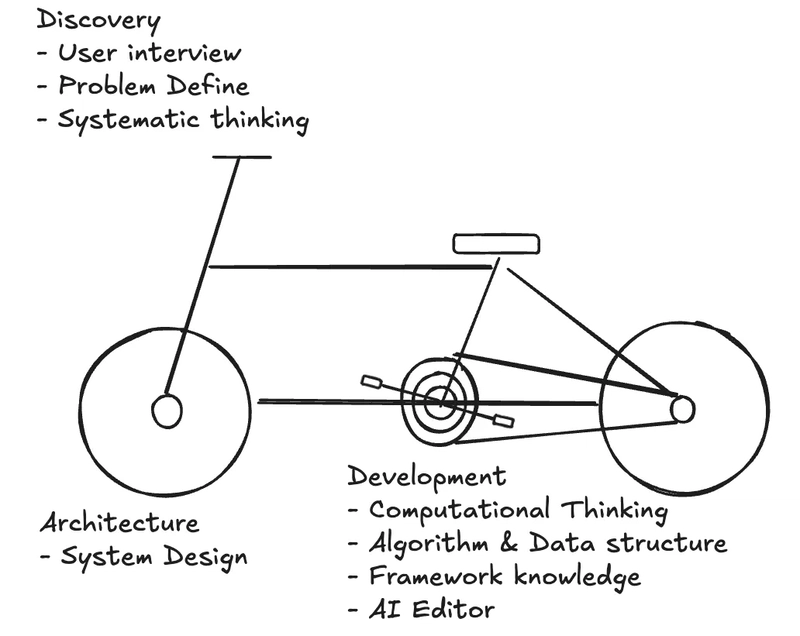Today's story is about the steep slope of rapid changes in the AI era and how Product Engineers can adapt. To illustrate what's necessary for adaptation, I’m using the analogy of riding a bicycle.
A Steep Slope
Thanks to advancements in AI, makers can now move as swiftly as if racing downhill. Even those without coding knowledge can easily create simple apps, provided they have problem awareness and creativity. This development will likely lead to a surge of diverse apps aimed at addressing inefficiencies across society. Moreover, those with development knowledge can now build richer functionalities more swiftly than ever. Some apps might stay at a prototype level, but many will achieve significantly higher quality.
In the U.S., even before AI’s rapid advancement, some developers were already earning a living from simple apps. For instance, a developer featured recently on Geeknews runs a wedding seating arrangement web app and makes a comfortable monthly income. As AI evolves further, I expect more of such examples—people solving real problems around them with technology, creating tangible business value, and sustaining themselves financially.
However, as more apps emerge to solve various problems, it might become challenging to find the perfect app tailored to an individual's specific needs. With too many apps available, and an inability to know them all, finding the right app could be tough. Yet, this challenge itself could be solved by AI. I imagine AI will evolve toward directly finding suitable apps for us.
One of the reasons I think this way is due to OpenAI's recent announcement of a new feature called Operator. To briefly describe the demo, when a user inputs a request like "Make a restaurant reservation for two at 7 pm" into Operator and selects an appropriate web app, the AI directly controls the computer, accesses the chosen web app, and completes the reservation. During this process, the human never touches the mouse or keyboard. The cursor clicks autonomously, inputs the necessary information, and completes the booking. Though a web app was used, there was zero human involvement in the interaction.
Currently, humans still choose the appropriate app within Operator, but soon even that selection might be handled by AI. It's an entirely plausible scenario if the AI learns human preferences.
The idea of AI selecting services on our behalf leads to another, perhaps even more shocking, shift: people may no longer be the primary users of digital services. Instead, making services user-friendly for AI could become a new competitive edge. We might need to consider developing interfaces tailored specifically for AI rather than humans.
Riding a Bicycle
When facing steep, rapid changes, new tools seem essential for adaptation. With advancements in AI affecting the very concept of user interfaces and more, the role of frontend engineers must evolve accordingly. Although there are many ways to evolve, I see expanding the role into Product Engineering as a compelling direction.
The core of a Product Engineer's role is Product Engineering. But what exactly is Product Engineering? To clarify, I've divided Product Engineering into three phases: Discovery, Architecture, and Development. To simplify understanding, I'll use the analogy of riding a bicycle.
Discovery (Handlebars)
Discovery acts like bicycle handlebars, setting the direction for Product Engineering. It involves recognizing real-world problems and translating them into solvable technical challenges. This stage includes user interviews to pinpoint users' genuine problems. Analyzing and reflecting on interview results helps define the true issue—not creating problems from thin air, but recognizing existing ones. Finally, systematic thinking is crucial, as it influences the next phase, Architecture.
Architecture (Front Wheel)
Architecture guides the direction set by Discovery, just as a front wheel follows the handlebars. It concretizes the path forward for Product Engineering, notably through system design. This stage outlines specifics about how Development will proceed. The more detailed context we provide AI Editors, the higher quality code they produce. With flexible, scalable architecture, developing complex apps becomes achievable.
Development (Rear Wheel and Gears)
Development propels Product Engineering forward, much like the rear wheel of a bicycle. The big gear provides substantial power but moves slowly, analogous to foundational skills (Computational Thinking, Algorithms & Data Structures). The small gear offers less power but moves quickly, similar to practical technical skills (Framework Knowledge, AI Editors). Just as climbing uphill requires the big gear and moving fast demands the small gear, both foundational and practical skills are crucial for effective development. These elements combine with the rear wheel (implementation) to drive Product Engineering forward.
Navigating the Steep Slope
As frontend engineers, we inevitably encounter steep slopes—such as rapid AI advancements. For those equipped with the right tools, such changes can become incredible opportunities. By preparing tools that suit us personally—like having the essential skills needed by frontend engineers to leverage AI advancements—we can lead rather than follow changes.
At the end of March, I'm launching the Product Engineer Community, a gathering of people riding bicycles together, navigating steep slopes with ease. Why not join us and enjoy the ride?
If you’d like to join the Product Engineer Community and ride along, please click the link below to subscribe :)




Top comments (0)